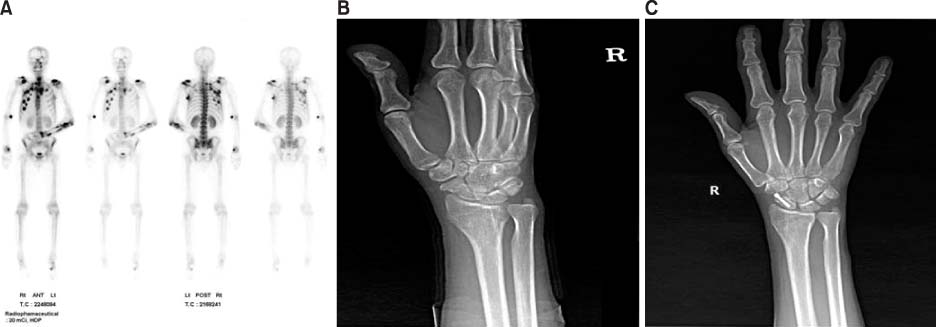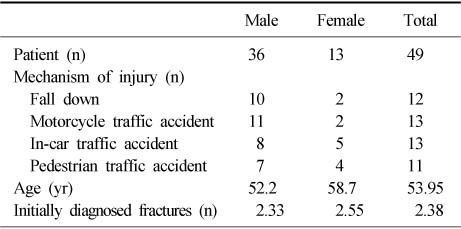Articles
- Page Path
- HOME > J Musculoskelet Trauma > Volume 27(4); 2014 > Article
-
Original Article
- Analysis of Missed Fractures in Polytrauma Patients
- Ki Chul Park, M.D., Hyun Uk Kim, M.D.
-
Journal of the Korean Fracture Society 2014;27(4):281-286.
DOI: https://doi.org/10.12671/jkfs.2014.27.4.281
Published online: October 20, 2014
Department of Orthopedic Surgery, Hanyang University Guri Hospital, Guri, Korea.
- Address reprint requests to: Ki Chul Park, M.D. Department of Orthopedic Surgery, Hanyang University Guri Hospital, 153 Gyeongchun-ro, Guri 471-701, Korea. Tel: 82-31-560-2318, Fax: 82-31-557-8781, kcpark@hanyang.ac.kr
• Received: May 9, 2014 • Revised: June 23, 2014 • Accepted: July 30, 2014
Copyright © 2014 The Korean Fracture Society. All rights reserved.
This is an Open Access article distributed under the terms of the Creative Commons Attribution Non-Commercial License (http://creativecommons.org/licenses/by-nc/3.0/) which permits unrestricted non-commercial use, distribution, and reproduction in any medium, provided the original work is properly cited.
- 424 Views
- 2 Download
Abstract
-
Purpose
- The purpose of this study is to determine the frequency of missed fractures in severe multiple trauma patients and to analyze any differences in treatment plan, after whole body bone scan.
-
Materials and Methods
- From September 2012 to December 2013, 49 patients were confirmed to have multiple trauma with an injury severity score (ISS) of 16 or higher. Whole body bone scan was performed at an average of 15.7 days (7-25) after injury. Missed fractures were diagnosed according to physical examination and additional radiologic reports. Locations and patterns of missed fractures were analyzed. We evaluated any differences in treatment plan after the diagnosis of missed fractures.
-
Results
- Missed fractures were diagnosed in 14 patients (16 cases) on the whole body bone scan. The most frequent location was the knee (three cases), followed by rib, clavicle, carpal bone, and foot. Seven cases were occult fractures, five cases were undisplaced fractures and four cases were displaced fractures. Conservative treatment was administered in 15 patients and surgery was necessary in one patient.
-
Conclusion
- Delayed or missed diagnosis of fractures occurred frequently in patients of multiple trauma with a high ISS. Whole body bone scan appears to be effective in finding missed fractures in the whole body. Definitive assessment should be supplemented after initial trauma care in order to reduce the rate of missed fractures.
- 1. Brooks A, Holroyd B, Riley B. Missed injury in major trauma patients. Injury, 2004;35:407-410.Article
- 2. Janjua KJ, Sugrue M, Deane SA. Prospective evaluation of early missed injuries and the role of tertiary trauma survey. J Trauma, 1998;44:1000-1006. discussion 1006-1007.Article
- 3. Schweitzer G. Re: Buduhan G. McRitchie DI. Missed injuries in patients with multiple trauma. J Trauma. 2000;49:600-605. J Trauma, 2001;51:179.
- 4. Vles WJ, Veen EJ, Roukema JA, Meeuwis JD, Leenen LP. Consequences of delayed diagnoses in trauma patients: a prospective study. J Am Coll Surg, 2003;197:596-602.
- 5. Baker SP, O'Neill B, Haddon W Jr, Long WB. The injury severity score: a method for describing patients with multiple injuries and evaluating emergency care. J Trauma, 1974;14:187-196.
- 6. Gruen RL, Jurkovich GJ, McIntyre LK, Foy HM, Maier RV. Patterns of errors contributing to trauma mortality: lessons learned from 2,594 deaths. Ann Surg, 2006;244:371-380.
- 7. Wei CJ, Tsai WC, Tiu CM, Wu HT, Chiou HJ, Chang CY. Systematic analysis of missed extremity fractures in emergency radiology. Acta Radiol, 2006;47:710-717.ArticlePDF
- 8. Berlin L. Defending the "missed" radiographic diagnosis. AJR Am J Roentgenol, 2001;176:317-322.Article
- 9. Guly HR. Diagnostic errors in an accident and emergency department. Emerg Med J, 2001;18:263-269.Article
- 10. Jank S, Deibl M, Strobl H, et al. Interobserver variation of the sonographic diagnosis of orbital floor fractures and fractures of the infraorbital margin. Mund Kiefer Gesichtschir, 2004;8:337-343.ArticlePDF
- 11. Mathews JD, Forsythe AV, Brady Z, et al. Cancer risk in 680,000 people exposed to computed tomography scans in childhood or adolescence: data linkage study of 11 million Australians. BMJ, 2013;346:f2360. Article
- 12. Copes WS, Champion HR, Sacco WJ, Lawnick MM, Keast SL, Bain LW. The injury severity score revisited. J Trauma, 1988;28:69-77.Article
- 13. Born CT, Ross SE, Iannacone WM, Schwab CW, DeLong WG. Delayed identification of skeletal injury in multisystem trauma: the 'missed' fracture. J Trauma, 1989;29:1643-1646.
- 14. Houshian S, Larsen MS, Holm C. Missed injuries in a level I trauma center. J Trauma, 2002;52:715-719.Article
- 15. Chan RN, Ainscow D, Sikorski JM. Diagnostic failures in the multiple injured. J Trauma, 1980;20:684-687.Article
- 16. Yang DC, Ratani RS, Mittal PK, Chua RS, Pate SM. Radionuclide three-phase whole-body bone imaging. Clin Nucl Med, 2002;27:419-426.Article
- 17. Hodler J, Steinert H, Zanetti M, et al. Radiographically negative stress related bone injury. MR imaging versus two-phase bone scintigraphy. Acta Radiol, 1998;39:416-420.ArticlePDF
- 18. Matin P. The appearance of bone scans following fractures, including immediate and long-term studies. J Nucl Med, 1979;20:1227-1231.
REFERENCES
Fig. 1A 41-year-old man had a left forearm bone fracture, left clavicle fracture, right scapula fracture, and multiple rib fractures due to a motorcycle accident. Bone scan was checked at two weeks after the accident. (A) Focal hot uptake was observed at the right scaphoid area. (B) A radiograph of the right wrist was checked and showed obvious scaphoid fracture. (C) Scaphoid fracture was treated with open reduction and internal fixation.


Figure & Data
REFERENCES
Citations
Citations to this article as recorded by 

Analysis of Missed Fractures in Polytrauma Patients

Fig. 1
A 41-year-old man had a left forearm bone fracture, left clavicle fracture, right scapula fracture, and multiple rib fractures due to a motorcycle accident. Bone scan was checked at two weeks after the accident. (A) Focal hot uptake was observed at the right scaphoid area. (B) A radiograph of the right wrist was checked and showed obvious scaphoid fracture. (C) Scaphoid fracture was treated with open reduction and internal fixation.
Fig. 1
Analysis of Missed Fractures in Polytrauma Patients
Patient Demographics
Table 1
Patient Demographics

 E-submission
E-submission KOTA
KOTA TOTA
TOTA TOTS
TOTS

 Cite
Cite

